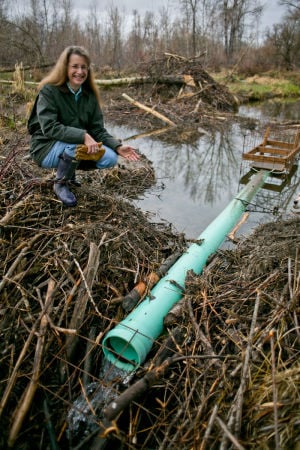Yesterday was a strangely successful day that turned out well for beavers. After writing about the Mystic lake madness I wrote the acting director of the Custer Gallatan Forest Service and some city folks protesting the decision to sit on this problem for three months and then expose the beavers to slow death. I was written back fairly promptly by that acting director saying the army corps of engineers had told them there was a risk of a 500-year flood event for the town below if the dam washed out. He assured me they knew about flow devices and would talk about this for the future, but had to do this now. The beavers would be trapped, not left to starve, which was something.
I was grimly comforted by this news, and mollified that he wrote back at all which I did not expect. He also said that he was back at his regular job now in Vermont and another ranger was in charge – whom he cc’d on the message so we could be in touch. I still thought the beavers were done for, but I was glad that my letter had been responded to.
45 minutes later I received this:
Update on Mystic Lake project. Engineers are currently working on a mitigation device to keep water to tolerable level after lowering and keeping the beavers in the system. Long term solutions will be discussed at a later date. Thanks.
Chad Benson
Deputy Forest Custer Gallatin National Forest

There must have been a lot of other public outcry besides mine. Maybe we’ll never know. I will say I am capable of writing a fairly decent letter, but am downright talented at finding the right email address to target even when folks work hard to hide it. Still, I can count on one hand the number of times something like this happens. Maybe it has something to do with Amy’s recent presentation on the topic and my reminding the ranger of her skills and the fact that she was trained by the man who solved our beaver problem a decade ago? Maybe someone chained themselves to a bulldozer or threatened to stop dating the mayor’s niece. Who knows how these things work?
I’m just happy it did!

To celebrate I started thinking about a festival design that would promote our new location and vaguely remembered a charming illustration by Elizabeth Saunders the artist who works with Cows and Fish. It was about beaver dispersal, but I thought it could easily be re-purposed to inspire Amelia on our brochure this year. Even as a starting place, I’m liking this a lot.

Today is full of blessings in every way! Louise Ramsay posted this on FB a very nice beaver program from radio 4. There are some irritating parts but stay patient because it gets very good. I especially find it kind of wonderful to hear how happily the reporter describes their return. Enjoy!











 For CFC’s inaugural Beaver Month we chatted with Andrew Jakes, Regional Wildlife Biologist for National Wildlife Federation about the unsung bucktooth heroes of the watershed – the beaver.
For CFC’s inaugural Beaver Month we chatted with Andrew Jakes, Regional Wildlife Biologist for National Wildlife Federation about the unsung bucktooth heroes of the watershed – the beaver.
 Amy will share facts of about beaver ecology, review how beaver act as ‘ecosystem engineers’ in western watersheds, and share the implications lost beaver habitats on our water budget. Chadwick will be joined by Andrew Jakes, Wildlife Biologist with the National Wildlife Federation for a discussion of beaver habitat recovery work underway in the Upper Clark Fork and a Q & A session.
Amy will share facts of about beaver ecology, review how beaver act as ‘ecosystem engineers’ in western watersheds, and share the implications lost beaver habitats on our water budget. Chadwick will be joined by Andrew Jakes, Wildlife Biologist with the National Wildlife Federation for a discussion of beaver habitat recovery work underway in the Upper Clark Fork and a Q & A session.








































